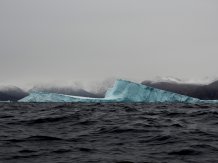
Photo by Lauren Candlish
More rain than snow will fall in the Arctic – and this transition will occur decades earlier than previously predicted, a new study reports.
Projections from the newest climate models, published by an international team led by the University of Manitoba in the journal Nature Communications, show a steep increase in precipitation expected to fall in the Arctic, and that most of it will be rain.
This shift is occurring due to rapid warming and sea-ice loss in the Arctic.
"There are huge ramifications of these changes, such as a reduction of snow cover, increased permafrost melt, more rain-on-snow events, and greater flooding events from increased river discharge, all of which have implications on wildlife populations and human livelihoods," said lead researcher Michelle McCrystall, a postdoctoral fellow in Manitoba's Centre for Earth Observation Science in the Clayton H. Riddell Faculty of Environment, Earth, and Resources.
Professor James Screen, of the Department of Mathematics and Global Systems Institute at the University of Exeter, said: "The new models couldn't be clearer that unless global warming is stopped, the future Arctic will be wetter; once-frozen seas will be open water, rain will replace snow."
This transition to a rain-dominated era in the Arctic is forecasted to commence at different times depending on the season and region.
In autumn, for instance, these new models predict the shift to occur between 2050-2080, whereas the old models predicted this to occur decades later.
And in what could be considered a harbinger, as these researchers were preparing their report, in August of this year rain fell for the first time in recorded history on the highest point of the Greenland ice sheet.
"The fact that we're getting rainfall on the summit of Greenland right now, and that we're maybe going to get more rainfall into the future – it kind of staggers me," McCrystall said.
The paper warns that reduced snow cover will further exacerbate Arctic and global warming through albedo feedbacks, increased winter CO2 fluxes, methane releases from soil, and thawing permafrost.
The precipitation change will also affect soil moisture and groundwater, and the underground fungal networks that support all above-ground flora.
And more rain than snow events can be devastating to wild caribou, reindeer and muskoxen populations: the rain may freeze and create layers of ice, inhibiting them from accessing forage buried under snow.
The research team – which includes members from the University College London, University of Colorado Boulder, University of Lapland and the University of Exeter – note that if we can remain under 1.5°C of global warming, then the transition to rainfall-dominated precipitation may not occur in some regions of the Arctic.
But if we continue on the current trajectory, which given current global policies means that we could reach 3°C global warming by the end of the century, that this transition will likely occur.
This research was undertaken, in part, thanks to funding from the Canada Research Chairs Program, the European Commission Research and Innovation (CHARTER) and the Natural Environment Research Council.
The paper is entitled: "New climate models reveal faster and larger increases in Arctic precipitation than previously projected."






